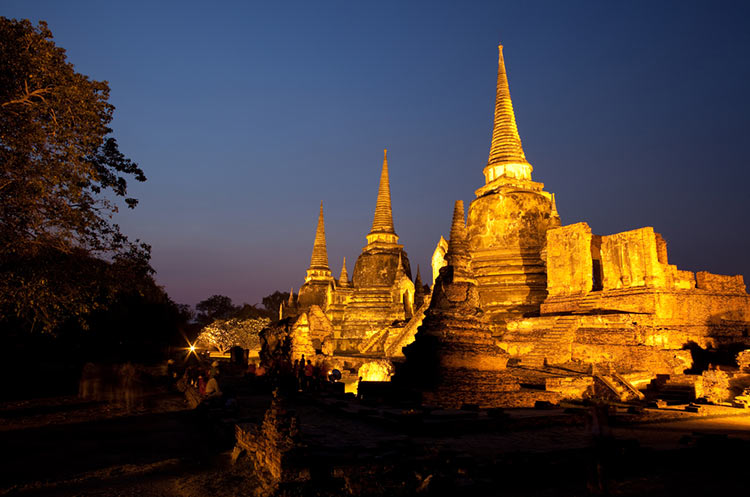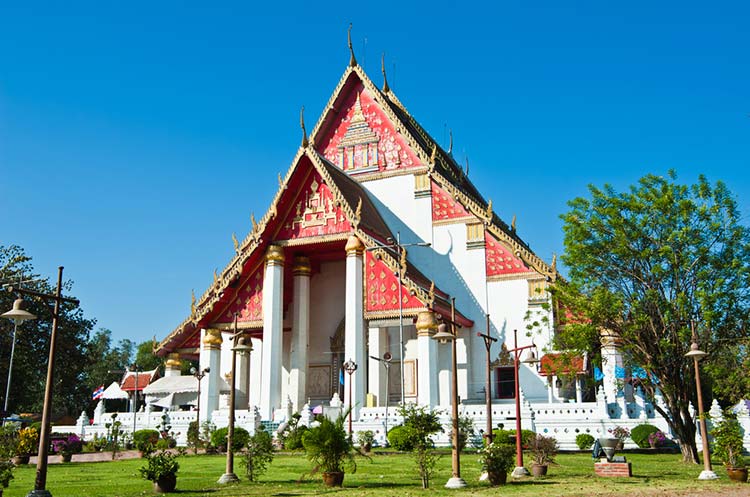
Temples & monasteries
Of the Ayutthaya Historical Park
The Kings of Ayutthaya have built many impressive temples, some of which were Royal temples where the Kings paid their respect to the Buddha and where monks were not allowed to live. Most of the major temples are located on the Ayutthaya island. Only a few like the Wat Chaiwatthanaram are off the island, just across the river.
Early Ayutthaya mountain temples
Early Ayutthaya temples were built following the design concepts of the Khmer mountain temples of Angkor. The main structures are aligned on an East West axis facing East, towards the Eastern territories ruled by the Hindu God Indra.
Mountain temples represent Mount Meru, the center of the universe in Hindu and Buddhist cosmology surrounded by mountain chains and oceans.
A large central prang surrounded by four smaller ones at each corner of a raised platform represents the five peaks of Mount Meru, the abode of the Gods. The enclosures around the temple symbolized the mountain chains surrounding Mount Meru, a moat or body of water surrounding the temple represented the cosmic oceans.
A few examples of Ayutthaya temples built following these concepts are Wat Mahathat, Wat Chaiwatthanaram and Wat Ratchaburana.
Most important temples
Among the grandest and most important temples of the Ayutthaya Kingdom are:
- Wat Mahathat
- Wat Chaiwatthanaram
- Wat Phra Si Sanphet
- Wat Ratchaburana
- Wat Phanan Choeng
- Wat Lokaya Sutha
- Wat Yai Chai Mongkhon
Wihan Phra Mongkhon Bophit
The Wihan Phra Mongkhon Bophit next to the Wat Phra Sri Sanphet is known for its enormous bronze Buddha image. The image named Phra Mongkol Bophit is in the Bhumisparsha mudra, calling the Earth to witness.
The temple was originally built in the 17th century. During the Burmese invasion of Ayutthaya in 1767 both the viharn and the Buddha image were seriously damaged. The current structure dates to halfway the 20th century.

Wat Thammikarat
The Wat Thammikarat is found near the old Royal Palace. Although the temple’s founding date is not known with certainty, it is believed to be in the 12th century, which would make it older than the city of Ayutthaya itself.
Much of the walls and pillars of a large viharn are still intact. The viharn enshrined a bronze image of the Buddha, the head of which is now exhibited in the Chao Sam Phraya National Museum. The head in the Wat Thammikarat temple is a copy.
A damaged chedi on the temple grounds is surrounded by 52 guardian Singhs, mythological animals that look like lions. Another structure on the grounds shelters a large reclining Buddha image.
Wat Phra Ram
The Wat Phra Ram is found on the island South East of the Royal Palace. Its name translates to “the temple of Rama”.
The temple was founded in the late 14th century when a Khmer style prang, a viharn and several chedis were constructed. In the 17th century four smaller prangs were added around the central prang as well as a surrounding gallery.
The corncob shaped central prang that stands on an elevated platform is decorated with sculpted Garudas. Parts of the walls of the surrounding gallery remain; in it are several broken images of the Buddha. Other buildings on the grounds include an ubosot or ordination hall, dozens of chedis and several viharns. The temple is set in a park like environment with several small lakes.
Temples in the Ayutthaya Historical Park
Ayutthaya Historical Park Tours
- From Bangkok
- Private or group tour
- Also visit other highlights like Bang Pa-In Summer Palace